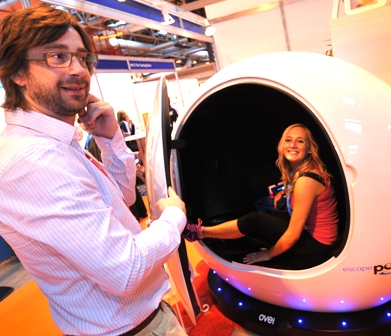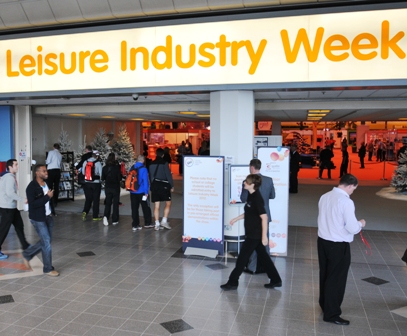
Open-door policy: exhibitors ready to welcome visitors at LIW
Three and out: it’s LIW time again
The exhibition we have learned to call Leisure Industry Week comes round early each autumn whether The Leisure Review wants it to or not. This year we sent a correspondent to see whether our continued disinterest is justified and whether the alternative headline – The Pig Got Up and Slowly Walked Away – would have worked.

Open-door policy: exhibitors ready to welcome visitors at LIW
Estimates vary as to when this magazine last sent a correspondent to Leisure Industry Week (LIW) but the pound was still strong, zumba had not been invented, Ralph Riley was in the corner office at ISRM and many were saying that the exhibition had better get its act together or it would not survive much longer. Since then the pound has taken a hammering and Riley has taken an early bath but zumba has cornered the housewife keep-fit market and what describes itself as the “leading event for the entire out of home leisure industry” is still with us. With an hour or so to spare on a trip south, our northern correspondent popped in to the first morning of the show to take its temperature.
Readers unfamiliar with the works of JRR Tolkien may not appreciate the allusion but much of the National Exhibition Centre (NEC) has about it the feel of a modern-day version of the mines of Moria, although without the goblins. Moria, which features in the first part of the interminable Lord of the Rings trilogy, is a subterranean kingdom that had pulsated with life in its heyday but, by the time it is visited by hobbits et al, has fallen into disuse; the vast halls and passageways lying empty, the vaulted spaces of the once-great kingdom now echoing to a single footfall. Rather like the NEC in post-credit crunch times.
In Tolkien, the wearied traveller is forced to trek for miles hunting for signs as to which road to take at every junction, trekking up vast stairways and down long, dark tunnels, always wondering if the journey will ever end. And that is what it is like getting from the NEC’s railway station to halls 17, 18 and 19, the venue for LIW.
Thankfully, as the destination finally hoves into sight all vestiges of Middle Earth are shaken off and the visitor is met by smiley women with nothing in their thoughts but speeding visitors along their way. Despite dire warnings about queues, bureaucracy and jobsworths, your correspondent had left his delegate badge safely pinned to the office notice board but this proved no barrier and two minutes after arriving outside hall 19 he was inside it.
Experts in exhibition management suggest three ad hoc ways to assess whether an event is doing well. Are there queues to get in on the first morning? Are there plenty of places to have a coffee with colleagues and plenty of tables to choose from? Do you feel hemmed in by stalls and buffeted by other delegates? LIW was queue-less, spacious and as claustrophobic as a full-sized football pitch being used by the under 11s, all of which means that by these measures it is not only The Leisure Review finds LIW’s offer underwhelming.
The exhibition has the usual array of exhibitors from its primary market, fitness. In line abreast the stately galleons that are Cybex International, Pulse Fitness and the Fitness Industry Association sight their broadsides on Precor, Technogym and Life Fitness, while in the leviathans’ wake bob lesser craft like PT: Portal (they do an IT system for personal trainers), Powerhoop (heavy-duty hula hoops) and PayasUgym, who generate leads for sales-people in gyms and health clubs.
Elsewhere there are swimming pool constructors and installers, indoor and outdoor play equipment suppliers and a flurry of management and marketing consultants. Three hundred companies, agents and associations all more or less associated with leisure as we know it. The question is, with money tight and visitor numbers not as they should be, why are exhibitors exhibiting?
When this question is put to Peter Cleaver of Fit Quote, a company that will source fitness equipment for you and is probably well-placed to understand the leisure industry, his answer is disarmingly simple. “They have to be,” he says. He then goes on to cite three reasons: “It’s the only purely trade show in the UK, which therefore means the big suppliers are bound to be there, which draws people who are seeking to buy.” Essentially his argument is that if you want to sell into the local authority market you have to be in that space that week. “If your competitors are here, you have to be.”
Charmed by Cleaver’s forthright honesty, the temptation was to check whether his perception matched up with the other side of the equation. Warwick Andrews is the managing director of a Leeds-based sports development and management consultancy, Logic Edge, who had found the time to spend at the exhibition. “I am here to get a sense of where the sector is, pick up some personal CPD and do a little networking,” he said, before heading off to try out an aerial walkway from Innovative Leisure which was attracting nearly as many middle-aged kids as the coffee machine company who were the only people with a truly busy stand.
He did not seem to have an order book with him but with so many exhibitors, former Big Brother contestants, public relations people and other non-combatants milling about it was hard to discern who did. While it may be laudable that the LIW people are enabling events such as the REPS national convention to “co-locate” with their exhibition, there is a concern that this is papering the house rather than contributing to the main objective of the event, which is matching sellers with buyers.
To paraphrase Benjamin Hapgood Burt, you can judge an exhibition by the celebrities it chooses and as The Leisure Review’s correspondent made his way to the entrance and the long walk back to the train station he passed Adam Corbally, late of The Apprentice television programme, setting up for whatever personal appearance he had been booked to be part of. Suffice it to say that the last time these two men’s paths crossed the former purchased a pound of tomatoes from the latter on their local market.
The Leisure Review, October 2012
© Copyright of all material on this site is retained by The Leisure Review or the individual contributors where stated. Contact The Leisure Review for details.
Download a pdf version of this article for printing
